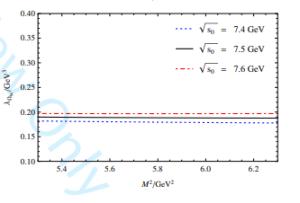|
[1]
|
M. Mattson et al (SELEX Collaboration), Phys. Rev. Lett., 89:112001(2002) doi:10.1103/PhysRevLett.89.112001[hep-ex/0208014]. |
|
[2]
|
A. Ocherashvili et al (SELEX Collaboration), Phys. Lett. B, 628:18(2005), doi:10.1016/j.physletb.2005.09.043,[hep-ex/0406033] |
|
[3]
|
S. P. Ratti, Nucl. Phys. Proc. Suppl., 115:33(2003), doi:10.1016/S0920-5632(02)01948-5 |
|
[4]
|
B. Aubert et al (BaBar Collaboration), Phys. Rev. D, 74:011103(2006), doi:10.1103/PhysRevD.74.011103,[hep-ex/0605075] |
|
[5]
|
R. Chistov et al (Belle Collaboration), Phys. Rev. Lett., 97:162001(2006), doi:10.1103/PhysRevLett.97.162001,[hep-ex/0606051] |
|
[6]
|
R. Aaij et al (LHCb Collaboration), JHEP, 1312:090(2013), doi:10.1007/JHEP12(2013)090, arXiv:1310.2538[hep-ex] |
|
[7]
|
Y. Kato et al (Belle Collaboration), Phys. Rev. D, 89(5):052003(2014), doi:10.1103/PhysRevD.89.052003, arXiv:1312.1026[hep-ex] |
|
[8]
|
R. Aaij et al (LHCb Collaboration), Phys. Rev. Lett., 119(11):112001(2017), doi:10.1103/PhysRevLett.119.112001, arXiv:1707.01621[hep-ex] |
|
[9]
|
H. X. Chen, Q. Mao, W. Chen, X. Liu, and S. L. Zhu, Phys. Rev. D, 96(3):031501(2017), doi:10.1103/PhysRevD.96.031501, arXiv:1707.01779[hep-ph] |
|
[10]
|
F. S. Yu, H. Y. Jiang, R. H. Li, C. D. L, W. Wang, and Z. X. Zhao, arXiv:1703.09086[hep-ph] |
|
[11]
|
W. Wang, F. S. Yu, and Z. X. Zhao, Eur. Phys. J. C, 77(11):781(2017), doi:10.1140/epjc/s10052-017-5360-1, arXiv:1707.02834[hep-ph] |
|
[12]
|
H. S. Li, L. Meng, Z. W. Liu, and S. L. Zhu, Phys. Rev. D, 96(7):076011(2017), doi:10.1103/PhysRevD.96.076011, arXiv:1707.02765[hep-ph] |
|
[13]
|
L. Meng, N. Li, and S. l. Zhu, arXiv:1707.03598[hep-ph] |
|
[14]
|
W. Wang, Z. P. Xing, and J. Xu, Eur. Phys. J. C, 77(11):800(2017), doi:10.1140/epjc/s10052-017-5363-y, arXiv:1707.06570[hep-ph] |
|
[15]
|
M. Karliner and J. L. Rosner, Phys. Rev. Lett., 119(20):202001(2017), doi:10.1103/PhysRevLett.119.202001, arXiv:1707.07666[hep-ph] |
|
[16]
|
T. Gutsche, M. A. Ivanov, J. G. Krner, and V. E. Lyubovitskij, Phys. Rev. D, 96(5):054013(2017), doi:10.1103/PhysRevD.96.054013, arXiv:1708.00703[hep-ph] |
|
[17]
|
H. S. Li, L. Meng, Z. W. Liu, and S. L. Zhu, arXiv:1708.03620[hep-ph] |
|
[18]
|
Z. H. Guo, Phys. Rev. D, 96(7):074004(2017), doi:10.1103/PhysRevD.96.074004, arXiv:1708.04145[hep-ph] |
|
[19]
|
Q. F. L, K. L. Wang, L. Y. Xiao, and X. H. Zhong, arXiv:1708.04468[hep-ph] |
|
[20]
|
L. Y. Xiao, K. L. Wang, Q. f. Lu, X. H. Zhong, and S. L. Zhu, Phys. Rev. D, 96(9):094005(2017), doi:10.1103/PhysRevD.96.094005, arXiv:1708.04384[hep-ph] |
|
[21]
|
N. Sharma and R. Dhir, arXiv:1709.08217[hep-ph] |
|
[22]
|
Y. L. Ma and M. Harada, arXiv:1709.09746[hep-ph] |
|
[23]
|
L. Meng, H. S. Li, Z. W. Liu, and S. L. Zhu, arXiv:1710.08283[hep-ph] |
|
[24]
|
R. H. Li, C. D. L, W. Wang, F. S. Yu, and Z. T. Zou, Phys. Lett. B, 767:232(2017), doi:10.1016/j.physletb.2017.02.003, arXiv:1701.03284[hep-ph] |
|
[25]
|
C. Y. Wang, C. Meng, Y. Q. Ma, and K. T. Chao, arXiv:1708.04563[hep-ph] |
|
[26]
|
Y. J. Shi, W. Wang, Y. Xing, and J. Xu, Eur. Phys. J. C, 78(1):56(2018), doi:10.1140/epjc/s10052-018-5532-7, arXiv:1712.03830[hep-ph] |
|
[27]
|
L. Y. Xiao, Q. F. L, and S. L. Zhu, arXiv:1712.07295[hep-ph] |
|
[28]
|
X. Yao and B. Mller, arXiv:1801.02652[hep-ph] |
|
[29]
|
Z. X. Zhao, arXiv:1805.10878[hep-ph] |
|
[30]
|
Z. P. Xing and Z. X. Zhao, arXiv:1807.03101[hep-ph]. |
|
[31]
|
P. Colangelo and A. Khodjamirian, In Shifman, M. (ed.):At the frontier of particle physics, vol. 31495-1576[hep-ph/0010175] |
|
[32]
|
L. J. Reinders and S. Yazaki, Nucl. Phys. B, 288:789(1987), doi:10.1016/0550-3213(87)90238-0 |
|
[33]
|
H. Castillo, C. A. Dominguez, and M. Loewe, JHEP, 0503:012(2005), doi:10.1088/1126-6708/2005/03/012,[hep-ph/0302271] |
|
[34]
|
V. V. Kiselev and A. V. Tkabladze, Sov. J. Nucl. Phys., 50:1063(1989),[Yad. Fiz., 50:1714(1989)] |
|
[35]
|
S. Narison, Phys. Lett. B, 198:104(1987), doi:10.1016/0370-2693(87)90168-7 |
|
[36]
|
N. Bilic, C. A. Dominguez, and B. Guberina, Z. Phys. C, 39:351(1988) |
|
[37]
|
L. J. Reinders and S. Yazaki, Phys. Lett. B, 212:245(1988), doi:10.1016/0370-2693(88)90533-3 |
|
[38]
|
A. A. Penin and M. Steinhauser, Phys. Rev. D, 65:054006(2002), doi:10.1103/PhysRevD.65.054006,[hep-ph/0108110] |
|
[39]
|
M. Neubert, Phys. Rev. D, 45:2451(1992), doi:10.1103/PhysRevD.45.2451 |
|
[40]
|
P. Colangelo, G. Nardulli, and N. Paver, Z. Phys. C, 57:43(1993), doi:10.1007/BF01555737 |
|
[41]
|
J. R. Zhang and M. Q. Huang, Phys. Rev. D, 78:094007(2008), doi:10.1103/PhysRevD.78.094007, arXiv:0810.5396[hep-ph] |
|
[42]
|
Z. G. Wang, Eur. Phys. J. A, 45:267(2010), doi:10.1140/epja/i2010-11004-3, arXiv:1001.4693[hep-ph] |
|
[43]
|
Z. G. Wang, Eur. Phys. J. C, 68:459(2010), doi:10.1140/epjc/s10052-010-1357-8, arXiv:1002.2471[hep-ph] |
|
[44]
|
Z. G. Wang, Eur. Phys. J. A, 47:81(2011), doi:10.1140/epja/i2011-11081-8, arXiv:1003.2838[hep-ph] |
|
[45]
|
T. M. Aliev, K. Azizi, and M. Savci, Nucl. Phys. A, 895:59(2012), doi:10.1016/j.nuclphysa.2012.09.009, arXiv:1205.2873[hep-ph] |
|
[46]
|
T. M. Aliev, K. Azizi, and M. Savci, J. Phys. G, 40:065003(2013), doi:10.1088/0954-3899/40/6/065003, arXiv:1208.1976[hep-ph] |
|
[47]
|
V. Braun, R. J. Fries, N. Mahnke, and E. Stein, Nucl. Phys. B, 589:381(2000), Erratum:[Nucl. Phys. B, 607:433(2001)], doi:10.1016/S0550-3213(00)00516-2, 10.1016/S0550-3213(01)00254-1,[hep-ph/0007279] |
|
[48]
|
D. Jido, N. Kodama, and M. Oka, Phys. Rev. D, 54:4532(1996), doi:10.1103/PhysRevD.54.4532,[hep-ph/9604280] |
|
[49]
|
A. Khodjamirian, C. Klein, T. Mannel, and Y.-M. Wang, JHEP, 1109:106(2011), doi:10.1007/JHEP09(2011)106, arXiv:1108.2971[hep-ph] |
|
[50]
|
C. Patrignani et al (Particle Data Group), Chin. Phys. C, 40(10):100001(2016), doi:10.1088/1674-1137/40/10/100001 |
|
[51]
|
Z. G. Wang, Commun. Theor. Phys., 66(3):335(2016), doi:10.1088/0253-6102/66/3/335, arXiv:1602.08711[hep-ph] |
|
[52]
|
M. A. Shifman, A. I. Vainshtein, and V. I. Zakharov, Nucl. Phys. B, 147:385(1979), doi:10.1016/0550-3213(79)90022-1 |
|
[53]
|
L. J. Reinders, H. Rubinstein, and S. Yazaki, Phys. Rept., 127:1(1985), doi:10.1016/0370-1573(85)90065-1 |
|
[54]
|
P. Colangelo, C. A. Dominguez, G. Nardulli, and N. Paver, Phys. Rev. D, 54:4622(1996), doi:10.1103/PhysRevD.54.4622,[hep-ph/9512334] |
|
[55]
|
Z. S. Brown, W. Detmold, S. Meinel, and K. Orginos, Phys. Rev. D, 90(9):094507(2014), doi:10.1103/PhysRevD.90.094507, arXiv:1409.0497[hep-lat] |
|
[56]
|
Z. G. Wang, Eur. Phys. J. A, 49:131(2013), doi:10.1140/epja/i2013-13131-7, arXiv:1203.6252[hep-ph] |
|
[57]
|
P. Colangelo and F. De Fazio, Phys. Lett. B, 387:371(1996), doi:10.1016/0370-2693(96)01049-0,[hep-ph/9604425] |
|
[58]
|
A. Lenz, Int. J. Mod. Phys. A, 30(10):1543005(2015), doi:10.1142/S0217751X15430058, arXiv:1405.3601[hep-ph] |
|
[59]
|
M. Kirk, A. Lenz, and T. Rauh, arXiv:1711.02100[hep-ph] |






 Abstract
Abstract HTML
HTML Reference
Reference Related
Related PDF
PDF
















 DownLoad:
DownLoad:
